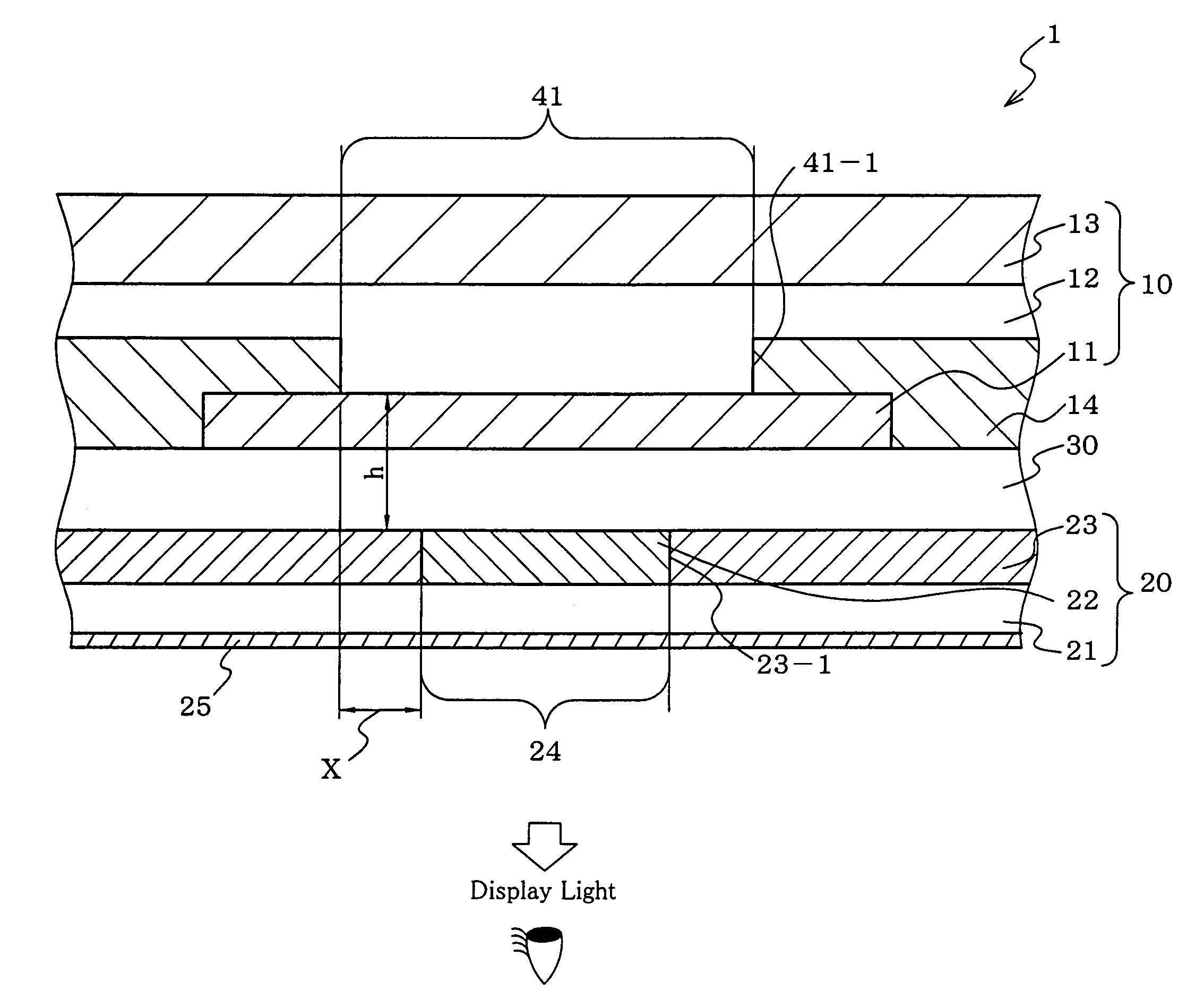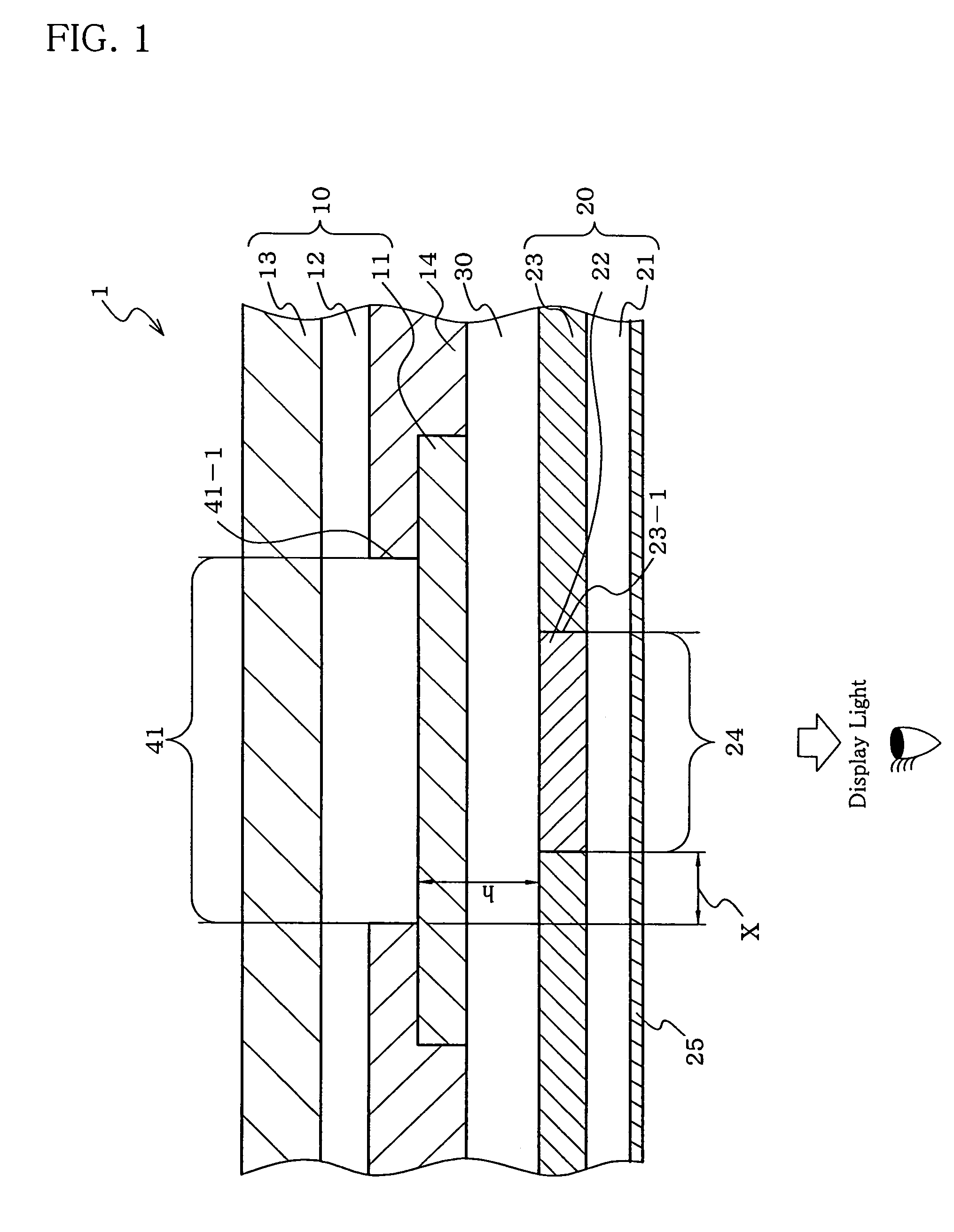Organic electroluminescence display device
a technology of electroluminescent display and organic el, which is applied in the direction of luminescnet screens, discharge tubes, identification means, etc., can solve the problems of difficult to see organic el, and achieve the effect of high contrast and external light incident at the edges of emission regions
- Summary
- Abstract
- Description
- Claims
- Application Information
AI Technical Summary
Benefits of technology
Problems solved by technology
Method used
Image
Examples
example 1
(1) Fabrication of Organic EL Display
[0144]V259BK (manufactured by Nippon Steel Chemical Co., Ltd.) as the material for a shielding layer (a black matrix: BM) was applied by spin coating to a supporting substrate (OA2 glass manufactured by Nippon Electric Glass Co., Ltd.) having dimensions of 112×143×1.1 mm. Then, ultraviolet rays were applied through a photomask so that a lattice-shaped pattern (an aperture region (A) in the shielding layer:60×280 μm) was formed. The material was then developed using a 2% sodium carbonate aqueous solution and baked at 200° C. to obtain a black matrix (thickness: 1.0 μm) pattern.
[0145]V259G (manufactured by Nippon Steel Chemical Co., Ltd.) as the material for a green color filter was applied by spin coating. Then, ultraviolet rays were applied through a photomask aligned with the BM so that 320 rectangular stripe patterns (90-μm line and 240-μm gap) were obtained. The material was then developed using a 2% sodium carbonate aqueous solution and baked...
example 2
(1) Fabrication of Organic EL Display
[0171]V259G (manufactured by Nippon Steel Chemical Co., Ltd.) as the material for a green color filter was applied by spin coating to a supporting substrate (transparent substrate) (OA2 glass manufactured by Nippon Electric Glass Co., Ltd.) having dimensions of 112×143×1.1 mm. Then, ultraviolet rays were applied through a photomask so that 320 rectangular stripe patterns (90-μm line and 240-μm gap) were obtained. The material was then developed using a 2% sodium carbonate aqueous solution and baked at 200° C. to obtain a green color filter (thickness: 1.0 μm) pattern.
[0172]V259R (manufactured by Nippon Steel Chemical Co., Ltd.) as the material for a red color filter was applied by spin coating. Then, ultraviolet rays were applied through a photomask the green color filter (displaced at 110 μm pitch) adjacent so that 320 rectangular stripe patterns (90-μm line and 240-μm gap) were obtained. The material was then developed using a 2% sodium carbona...
example 3
[0187]An organic EL display was fabricated under the same conditions as in Example 2 except that the thickness of a transparent medium (flattenizing film) was 6.8 μm.
[0188]The perpendicular distance h of the organic EL display was 7.0 μm, the overlapping part X was 5.0 μm and X / h was 0.71.
[0189]As a result of the contrast evaluation done in the same method as in Example 1, it was found that when fluorescent light of 1000 lux was illuminated, the contrast of the organic EL display was 100 (luminance during emission):1.0 (luminance during non-emission), that is, 100:1.
PUM
 Login to View More
Login to View More Abstract
Description
Claims
Application Information
 Login to View More
Login to View More - R&D
- Intellectual Property
- Life Sciences
- Materials
- Tech Scout
- Unparalleled Data Quality
- Higher Quality Content
- 60% Fewer Hallucinations
Browse by: Latest US Patents, China's latest patents, Technical Efficacy Thesaurus, Application Domain, Technology Topic, Popular Technical Reports.
© 2025 PatSnap. All rights reserved.Legal|Privacy policy|Modern Slavery Act Transparency Statement|Sitemap|About US| Contact US: help@patsnap.com



